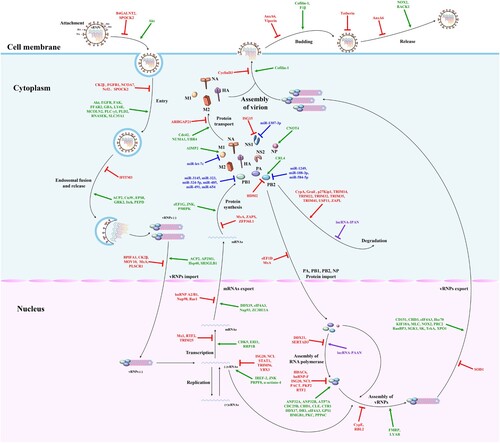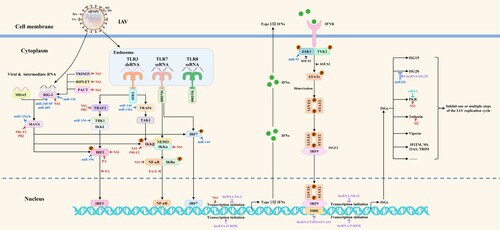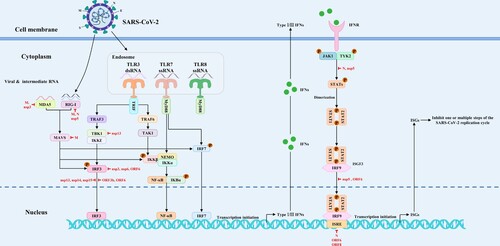Figures & data
Figure 1. The mapping of antiviral drug targets focusing on IAV replication cycle. A complete IAV replication cycle consists of four stages: attachment, entry and uncoating, replication and transcription, assembly and release. Host restriction factors, supportive host factors, microRNAs, and lncRNAs can regulate IAV replication by directly acting on one or multiple steps of the IAV replication cycle. Theoretically, these host biomolecules, which regulate the viral replication cycle and each of these steps in the viral replication cycle, could be used as potential antiviral drug targets. Green lines indicate that supportive host factors target one or multiple steps of the IAV replication cycle. Red lines indicate that host restriction factors target one or multiple steps of the IAV replication cycle. Purple lines indicate that lncRNAs target one step of the IAV replication cycle. Blue lines indicate that microRNAs target IAV proteins.

Figure 2. The mapping of antiviral drug targets focusing on host innate immune responses against IAV. The host PRRs can recognize dsRNA or ssRNA during IAV replication and quickly activate the innate immune signaling pathways to induce the expression of interferons and downstream ISGs, thereby inhibiting one or multiple steps of the IAV replication cycle. Meanwhile, IAV has evolved multiple strategies to directly or indirectly antagonize host innate immunity at transcriptional, translational, post-translational modification, and epigenetic levels. Notably, microRNAs, lncRNAs, and vtRNAs regulate innate immune signaling pathways. Theoretically, these host biomolecules, which regulate the host innate immune signaling pathways and the viral antagonism of host innate immune responses, could be used as potential antiviral drug targets. The red, blue, purple, peacock blue lines respectively indicate that IAV proteins, microRNAs, lncRNAs, vtRNAs target various steps of host innate immune signaling pathways.

Figure 3. The mapping of antiviral drug targets focusing on SARS-CoV-2 antagonism of host innate immune signaling pathways. On the one hand, SARS-CoV-2 infection activates the host innate immune signaling pathways, thereby promoting the expression of type I/III interferons and downstream ISGs. On the other hand, SARS-CoV-2 can suppress the expression of interferons and downstream ISGs by targeting and inhibiting PRRs, signaling proteins, transcription factors, and interferon-activated JAK/STAT signal transduction. Theoretically, the viral antagonism of host innate immune signaling pathways could be used as potential antiviral drug targets. The red lines indicate that SARS-CoV-2 proteins target various steps of host innate immune signaling pathways.

Table 1. Roles of host restriction factors that inhibit IAV replication.
Table 2. Roles of supportive host factors that promote IAV replication.
Table 3. Roles of microRNAs involved in regulating IAV replication.
Table 4. Roles of lncRNAs involved in regulating IAV replication.
Table 5. Strategies of IAV to antagonize host innate immune signaling pathways.
